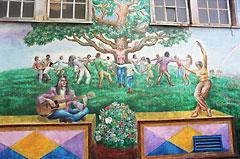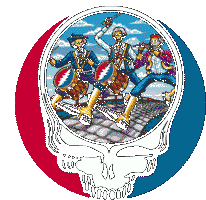Article on Haight/Ashbury



From the Modesto Bee
Love Haight RelationshipRight on! Vestiges remain of the Summer of Love, but gentrification is creeping into hippiedom's mercurial mecca
Scenes seen on Haight Street, which remains a colorful, offbeat and vibrant tribute to flower power, hippies and the iconoclastic 1960s. THE ASSOCIATED PRESS
Visitors love it or Haight it
A Haight-Ashbury mural depicts the 'back to the land' movement that lured hippies into rural America. THE SACRAMENTO BEE
Youth still hang out, but Haight Street has cleaned up its act. THE SACRAMENTO BEE
Don't look for the Hippie Museum on Haight Street. There isn't one. But your quest for all things, past and present, related to hippies and the 1960s -- the good ol' days -- are addressed at several Web sites, including www.hippiemuseum.org.
JANET FULLWOODTHE SACRAMENTO BEE
Last Updated: July 17, 2005, 05:55:48 AM PDT
SAN FRANCISCO — The generations that wore flowers in their hair and preferred to make love and not war poured into the Haight Ashbury vortex in droves.
It was an urban starship with a cast of characters that included hippies, yippies, Hells Angel's, Diggers, musicians, artists, seekers and searchers. Peace, love and spare change became the battle cry of the generation in search of itself.
Today the Haight — 18 blocks of grit, grime and psychedelic mercantilism that runs up against Golden Gate Park — has replaced beans and rice with fern bars. There are more ATM machines than roach clips.
One of the survivors — flourishers — is Gary Ehrke. He came to San Francisco during the Summer of Love.
He was an antiwar activist from Iowa seeking peace, love and rock 'n' roll in the most happening place in the country. To this day he remembers the exact words that set him on his liberal path, words read aloud to him by the mother of a childhood friend sent to fight in Vietnam.
"Don't enlist," the distressed young soldier pleaded in a letter home. "We shoot women and children in the head."
It was enough to send Ehrke straight to the Haight in his Chevy CorVan, a knockoff of the Volkswagen classic. The vehicle served as home for a while, until a room in a communal house became available.
"By the time I got here, people were living in all types of vehicles, including one guy who lived in an old Rolls-Royce," he reminisces. "If it weren't for the VW van, I don't think there would have been a Haight-Ashbury."
Ehrke should know: He's seen it all, from the heady days of 1967 right up to the present.
The transplanted Midwesterner with impeccable hippie credentials today works in theater, serving on the side as a guide for Haight-Ashbury Flower Power Walking Tours.
Wearing black pants, black boots, black turtleneck, black leather jacket and black shades reminiscent of those once called "granny glasses," the now gray-haired Ehrke meets his charges on a bus-stop bench at the corner of Stanyan and Waller streets, at the far east end of Golden Gate Park.
The mind wanders
The 2½-hour saunter through the neighborhood that follows is filled with anecdotes so vivid that we can almost hear Janis Joplin and Jimi Hendrix wailing and smell the pot smoke wafting over the psychedelic collage that was Haight Street — and still is, in a gussied-up sort of way.
"The way it developed," Ehrke says of the Haight's heyday, "was that in the early '60s, families were fleeing to the suburbs. In around 1962, people like the Jefferson Airplane, the Grateful Dead, Janis Joplin — musicians who had lived in North Beach, been involved in the Beat movement — came here and found a whole lot of empty houses in a rundown, working-class neighborhood.
"Later," he continues, "these musical groups started getting famous — and the neighborhood started getting famous, too."
Houses in the neighborhood are worth millions now, and rents on Haight Street are astonomical. Ben & Jerry's and The Gap occupy prominent pieces of real estate. But they're the exceptions rather than the rule.
"The Gap gets its windows broken very frequently," says Ehrke. "Corporate groups don't do well in this neighborhood."
Instead, the '60s live on in several key blocks lined with retail outlets devoted to the moods, styles and esoteric themes popularized by hippie culture. You can still buy Indian bedspreads and bead curtains on Haight Street, along with bell-bottom jeans and trinkets from Nepal. Psychedelic poster art is alive and very visible. Colors swirl from doorways, music throbs behind the scenes.
The sidewalks hold their own exotica: people with purple hair and pierced elbows, a juggler dressed in Merlin robes, burnedout druggies in tie-died rags.
A clean-cut young man from Hawaii was selling cannabis cookie cutters on a corner when I passed by. The self-proclaimed "hemp activist" said he was working for an Oregon-based family of artisans that "takes people's hemp-related ideas and helps produce them."
The cookie cutters were $7 each or two for $12 — about what an ounce of the real thing would have cost back in 1967.
Cannabis cookie-cutters are one thing, hard drugs another. And if drugs were what brought the Haight down, back in the early 1970s, they're still the neighborhood's scourge.
As part of the tour, Ehrke leads us past the landmark Haight-Ashbury Free Clinic, started by medical students in the 1960s and still operating on donations.
Drugs, he points out, were part of the Haight's landscape long before there were hippies.
"See this?" he says, pointing to a line of molding on the side of a faded Victorian that once belonged to a ship captain. "It's called the egg-and-dart pattern, but if you look closely, you can see it's really an opium poppy and scraper."
Ehrke's tour takes the group through lots of history — musical, cultural, literary, architectural. We see houses once inhabited by Joplin, Country Joe, Chet Helms and members of the Jefferson Airplane. And we pay our respects at the most famous address in the neighborhood, 710 Ashbury, one-time home of the Grateful Dead.
"The group lived here from 1965 to 1969 — and the Hell's Angels lived right across the street," Ehrke says, explaining that the gate across the front steps was erected only recently, to keep fans from running up on the porch and snapping pictures.
Time warp
Rudy Flores, from Chicago, is one of several people standing on the sidewalk, staring at the house, as our tour group passes by. "Man, this neighborhood, it's like time stood still," he says, shaking his head before heading downtown to Macy's, where '60s rock icon Carlos Santana is making an appearance to promote his line of clothing.
Ehrke leads us next to the corner of Waller and Belvedere, where an expansive mural, painted in the early 1970s, depicts the back-to-the-land movement that drew many in the hippie culture out of San Francisco to then-rural areas like Marin and Humboldt counties.
"Haight-Ashbury crashed and burned around 1970, '71," he says as we examine a section of the painting depicting the geo-desic dome dwelling popularized by Buckminster Fuller. "The healthy living groups were replaced by other groups that couldn't survive by themselves."
We learn, too, about Haight-Ashbury's days as a late 19th-century resort neighborhood, home to an amusement park and a baseball stadium.
"You could come out here in an omnibus drawn by horses — until an animal rights group stepped in a stopped it," he says. "From here you could take a steam train to the coast and back."
A McDonald's parking lot covers the place where the trains once turned around.
Since its development as a residential neighborhood in the early 1900s, Haight-Ashbury has been one of the city's premier repositories of Victorian architecture. Many of the old homes were beautifully restored in the prosperous 1980s and '90s. Behind a few still stand the quaint old carriage houses once shared by several families.
We peer through a knothole in a fence to see one that has been converted into apartments. "Carriage houses became obsolete when cars came around, but now are among the most sought-after properties in the city because they're off the street and quiet," our guide says.
We end up at another place that's off the street and quiet: the dining room of the Herb 'n Inn, a sometimes bed-and-breakfast run by Ehrke's Flower Power business partner, Pam Brennan ("minimum stay: one person, one-month, $1,300, private bath, double add $200").
The room is the nearest thing Haight-Ashbury has to a museum of hippie history. Vintage posters and photographs cover the walls; the table is strewn with scrapbooks filled with newspaper clippings from the '60s.
There's a Haight-Ashbury CD for sale, wouldn't you know. And on it is a video clip of a very young Bob Weir of the Grateful Dead extolling with all sincerity: "I think personally that the more people who turn on, the better the world is going to be."
Don't we all wish it had turned out to be that simple?



0 Comments:
Post a Comment
<< Home